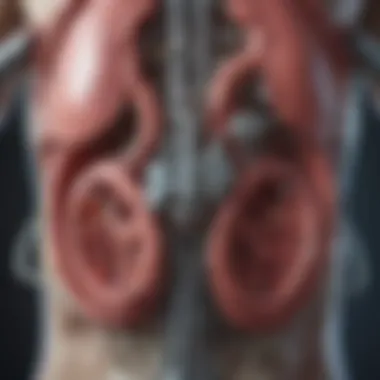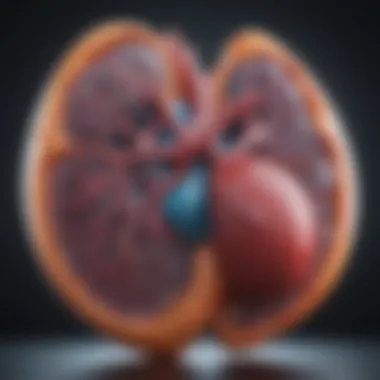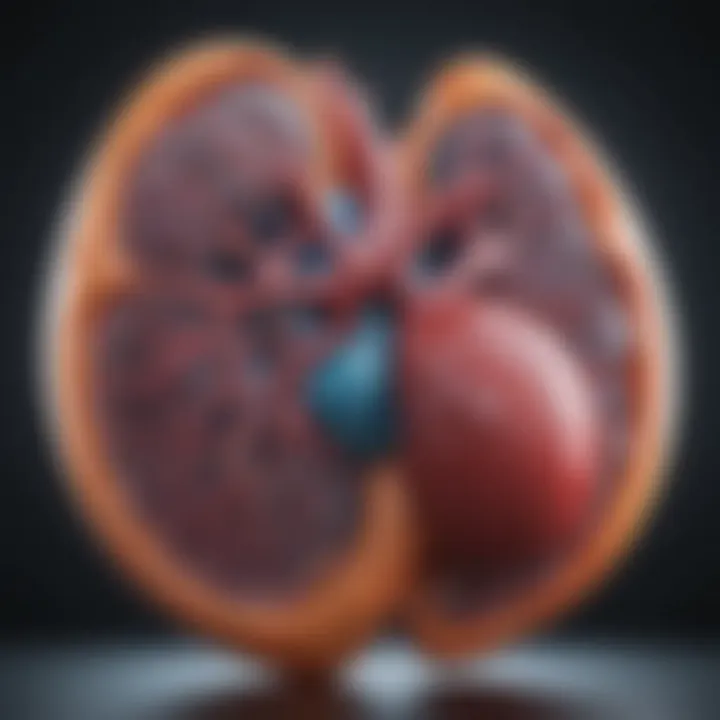Exploring Bio Artificial Kidneys: Innovations Ahead


Intro
The development of renal replacement therapies has long been an area of innovation within medical science. With kidney diseases rising globally, there exists a pressing demand for effective treatments. Recent advancements have led to the emergence of the bio artificial kidney, a hybrid system that merges biological elements with artificial structures to create a new paradigm in renal therapy. This essay examines what the bio artificial kidney entails, the advancements it brings, and the implications for both healthcare and medical research.
Article Overview
Purpose of the Article
The main purpose of this article is to present a thorough examination of the bio artificial kidney. It aims to inform readers about its technological foundations and clinical applications. By doing so, it seeks to highlight the ongoing research in the field and present future directions that might be taken. This technology represents an innovative approach to managing kidney failure, making it crucial for students and professionals in medical fields to understand its potential.
Relevance to Multiple Disciplines
The bio artificial kidney is not just relevant to nephrologists or urologists; its implications span various disciplines. It can interest biomedical engineers, researchers in regenerative medicine, and even ethicists examining healthcare protocols. The intersection of biology and technology attracts diverse perspectives, fostering interdisciplinary collaboration that can advance patient care.
Research Background
Historical Context
The evolution of kidney treatment has progressed from dialysis to kidney transplants, which have their limitations. In the 1960s and 1970s, significant efforts were made in artificial organ development. However, these solutions often failed to replicate the complex functions of natural kidneys. The bio artificial kidney represents a convergence of fifteen years of research, building on custom technologies that use living cells integrated within an artificial scaffold. This progression illustrates ongoing attempts to improve quality of life for patients suffering from renal insufficiencies.
Key Concepts and Definitions
Before delving deeper into the bio artificial kidney, it is important to clarify some terms:
- Bio Artificial Kidney: This system integrates living kidney cells with artificial structures to mimic natural kidney functions.
- Renal Replacement Therapy: A treatment method for kidney failure that includes dialysis and transplants.
- Biocompatibility: The ability of a material to perform with an appropriate host response when implanted.
These terms help frame the discussion surrounding the bio artificial kidney and its applications in modern medicine.
The bio artificial kidney combines the advantages of living tissue with technological advances to create a potential new standard in renal care.
The bio artificial kidney combines the advantages of living tissue with technological advances to create a potential new standard in renal care.
Prelims to Bio Artificial Kidneys
The introduction of bio artificial kidneys marks a pivotal moment in medical science, especially for those suffering from renal failure. This topic is significant as it combines the fields of biology, engineering, and medicine to create a novel solution that has the potential to revolutionize renal replacement therapy. Understanding the intricacies of bio artificial kidneys can provide insights into their functionalities, benefits, and the myriad considerations that accompany their development and implementation in clinical settings.
One essential element of bio artificial kidneys is their dual nature; they incorporate biological mechanisms alongside artificial constructs. This integration allows for more effective filtration and waste removal compared to conventional dialysis methods. Patients can benefit from improved outcomes and enhanced quality of life as these devices mimic natural kidney functions more closely than traditional treatments.
Furthermore, innovation in this area invites discussions on ethical and logistical implications associated with its use. As the technology advances, it raises important questions around accessibility, patient choice, and the capabilities of existing healthcare systems to incorporate such advanced interventions.
Technological Foundations of Bio Artificial Kidneys
The technological foundations of bio artificial kidneys play an essential role in their development and functionality. Understanding these foundations is crucial for grasping how these innovative devices can revolutionize kidney failure treatment. By merging biological elements with engineered enhancements, bio artificial kidneys aim to replicate natural kidney functions more efficiently than traditional dialysis methods. This section will explore key components such as biomaterials, cellular components, and the integration of artificial systems.
Biomaterials Used in Bio Artificial Kidneys
Biomaterials are fundamental to the design of bio artificial kidneys. They serve as the physical framework that supports various cellular components, while also ensuring biocompatibility and functionality. Ideally, biomaterials should promote cell attachment, growth, and differentiation, while minimizing any adverse immune responses.
Commonly used biomaterials include polymers, ceramics, and composite materials. Each type offers distinct benefits that can enhance the performance of bio artificial kidneys:
- Polymers such as polycaprolactone and polyethylene glycol are favored for their flexibility and ease of fabrication.
- Ceramics, like hydroxyapatite, provide structural support and enhance integration with living tissues.
- Composite materials combine properties of both polymers and ceramics, offering enhanced functionality and biocompatibility.
The selection of appropriate biomaterials is critical. It affects not only the efficiency of filtration and waste removal but also the longevity and safety of the device.
Cellular Components and Their Roles
Cellular components within bio artificial kidneys are pivotal for replicating the nephron's various functions. These cells perform critical processes such as filtration, reabsorption, and secretion. Key cellular elements often used in bio artificial kidneys include renal epithelial cells and endothelial cells.
Renal epithelial cells are responsible for filtering blood and reabsorbing essential nutrients. They help to mimic a natural nephron's ability to maintain homeostasis.


Endothelial cells form the lining of blood vessels and are crucial for regulating blood flow and filtration rates. Together, these cells contribute to a more physiological response to waste processing compared to conventional methods.
Integrating these cellular components into biomaterials requires precision and expertise. This ensures that the cells remain viable and functional within the bio artificial kidney system.
Integration with Artificial Components
Integrating biological and artificial components is a significant aspect of designing bio artificial kidneys. This integration is essential for mimicking healthy renal function while leveraging technology's stability and durability. Components often seen in such integrations include artificial membranes, sensors, and pumps.
- Artificial membranes act as semipermeable barriers, enabling selective filtration. They are crucial for waste removal while retaining necessary substances in the bloodstream.
- Sensors monitor parameters such as pressure and composition of the fluids, optimizing the kidney's efficiency and preventing complications.
- Pumps regulate the circulation of blood and fluids through the system. They ensure smooth operation and mimic the kidney's natural filtration process.
The synergy between biological and artificial elements is key for the efficacy of bio artificial kidneys. Achieving a successful integration is challenging yet crucial for device performance.
The development of bio artificial kidneys emphasizes the potential of combining biological and technological advancements to address critical healthcare challenges.
The development of bio artificial kidneys emphasizes the potential of combining biological and technological advancements to address critical healthcare challenges.
In summary, the technological foundations underpinning bio artificial kidneys are vital for their functionality and success in renal therapy. This understanding of biomaterials, cellular components, and integration techniques serves as a cornerstone for future research and developments.
Mechanisms of Action
Understanding the mechanisms of action in bio artificial kidneys is essential due to their groundbreaking role in renal replacement therapy. These devices replicate the essential functions of natural kidneys by employing various technologies and biological components. This section aims to uncover the intricate processes that allow bio artificial kidneys to effectively filter blood, transport substances, and metabolize waste products. Each subsection will delve into specific mechanisms to illustrate their importance in achieving satisfactory patient outcomes.
Filtration Mechanisms in Bio Artificial Kidneys
The filtration mechanisms employed by bio artificial kidneys are pivotal for their function. These kidneys utilize a combination of semi-permeable membranes and biological materials to replicate glomerular filtration. When blood enters the system, it passes through these membranes that allow for the selective removal of waste products while retaining essential cells and proteins.
Key components of this filtration include:
- Membrane Technology: Advances in membrane technology have introduced materials like polyethersulfone and polyethylene, which enhance blood compatibility and efficiency.
- Hydrodynamic Flow: The design also optimizes the flow of blood, ensuring a smoother transition through the filters. This reduces clotting and ensures maximum waste removal.
- Micro- and Nano-scale Structures: Innovations at the micro and nano levels create a higher surface area for filtration, increasing the device's overall performance.
These elements converge to make filtration not only a mechanical process but also a more biological one, closely simulating natural kidney function.
Transport Processes Involved
Transport processes are fundamental in bio artificial kidneys for maintaining electrolyte balance and ensuring proper blood chemistry. Transport across membranes is driven by both passive diffusion and active transport mechanisms.
Key transport processes include:
- Electrolyte Reabsorption: Transporters actively reabsorb electrolytes such as sodium and potassium, critical for maintaining homeostasis.
- Water Reabsorption: Utilizing osmotic gradients, water is efficiently reabsorbed, which is crucial for regulating fluid balance.
- Acid-Base Balance: Bicarbonate transporters help in maintaining acid-base homeostasis, neutralizing metabolic acids and stabilizing blood pH.
These processes reflect how the bio artificial kidney not only removes waste but also maintains critical physiological parameters in the body.
Metabolic Functions and Waste Processing
Bio artificial kidneys also possess metabolic functions that enhance waste processing beyond simple filtration. The integration of viable cells within the device allows for additional biochemical reactions that simulate kidney metabolism.
Noteworthy metabolic functions include:
- Urea and Creatinine Processing: Renal cellular components, such as renal tubular cells, can metabolize urea and creatinine, further cleansing the blood.
- Ammonia Detoxification: Certain cells can metabolize ammonia into urea, helping to alleviate toxic buildup in the bloodstream.
- Hormonal Regulation: These devices can also play a role in regulating erythropoietin and vitamin D synthesis, contributing to blood health and bone metabolism.
Clinical Applications and Current Research
The exploration of clinical applications and current research on bio artificial kidneys plays a crucial role in understanding how this technology may reshape renal therapy. With kidney diseases on the rise, particularly chronic kidney disease, innovative solutions are urgently needed. Bio artificial kidneys not only aim to restore kidney function but also to enhance patients' quality of life. This section examines the latest advancements in research, promising clinical trials, and compares the effectiveness of bio artificial kidneys against traditional dialysis methods.
Current Developments in Bio Artificial Kidney Research
Recent research has invigorated the field of bio artificial kidneys. Scientists are investigating various approaches to improve the design and functionality of these devices. Sophisticated biomaterials are being developed to better mimic the natural kidney environment.
One example includes the use of polymeric membranes, which exhibit superior filtration characteristics. These membranes can effectively separate toxins from the blood while allowing essential substances to pass through. Additionally, the integration of living cells into these systems aims to recreate the metabolic functions of the kidneys. This ongoing research indicates a commitment to creating a long-term solution for patients who rely on kidney replacement therapies.
"Innovations in biomaterials and cellular integration are the cornerstone of bio artificial kidney development."


"Innovations in biomaterials and cellular integration are the cornerstone of bio artificial kidney development."
Clinical Trials and Patient Outcomes
Clinical trials are a critical step in translating research into practical applications. The outcomes of these trials provide insights into the safety and efficacy of bio artificial kidneys. Several studies have shown promising results. For instance, trials involving devices like the AWAK (Automated Wearable Artificial Kidney) have demonstrated improved patient mobility and autonomy compared to conventional dialysis treatments.
Patients participating in these trials report higher satisfaction levels, primarily due to the reduced frequency of treatments. This suggests that bio artificial kidneys may not only improve health outcomes but also enhance the overall patient experience.
Comparative Analyses with Traditional Dialysis
When considering kidney replacement therapies, it is essential to compare bio artificial kidneys with traditional dialysis. While dialysis effectively manages kidney failure, it has limitations. Patients undergo treatments multiple times a week, which can be time-consuming and uncomfortable.
In contrast, bio artificial kidneys offer potential advantages:
- Improved patient autonomy: Patients may have options for home-based treatments.
- Better metabolic function: Incorporating living cells can lead to more natural metabolic processes.
- Enhanced quality of life: Less frequent treatments can result in increased freedom for patients.
Challenges in Implementation
The integration of bio artificial kidneys into clinical practice presents several challenges. These hurdles are critical in determining the feasibility and effectiveness of this innovative approach to renal replacement therapy. Understanding these challenges is essential to navigate the complexities of developing and applying bio artificial kidneys in real-world settings.
Biocompatibility Issues
One of the foremost challenges faced in the implementation of bio artificial kidneys is biocompatibility. Biocompatibility refers to how well a device interacts with biological systems without triggering adverse reactions. Bio artificial kidneys must be designed with materials that do not provoke an immune response. Issues related to biocompatibility can lead to thrombosis, inflammation, or even organ rejection. Researchers focus on identifying materials that are well-tolerated by the human body. Some proposed materials include polyurethane and specific silicon-based compounds, but continuous testing is crucial to ascertain their long-term effects in vivo.
Technical Limitations and Engineering Challenges
The engineering of bio artificial kidneys also poses significant technical limitations. Developing a device that effectively mimics the complex functions of natural kidneys is inherently difficult.
- Size and Integration: The dimensions of bio artificial kidneys must allow for seamless integration with existing anatomical structures. Oversized components can lead to complications, resulting in device failures or positioning difficulties.
- Functional Capabilities: It is vital that these devices replicate essential kidney functions, such as filtration, reabsorption, and secretion. Existing technology may not adequately support all these processes simultaneously.
- Durability and Maintenance: Long-term functionality is essential. Current models may face wear and tear issues and require frequent maintenance or replacement.
Regulatory Hurdles and Approval Processes
Navigating the regulatory landscape is another significant challenge. Regulatory bodies such as the U.S. Food and Drug Administration (FDA) impose rigorous standards for approval. This process can be complex and time-consuming.
- Clinical Trials: Extensive clinical trials are necessary to ensure safety and efficacy. These trials must demonstrate clear advantages over existing therapies.
- Approval Delays: The lengthy approval processes can hinder innovation, delaying access to potentially life-saving technologies.
- Standards and Guidelines: Establishing uniform standards for bio artificial kidneys poses difficulties. Discrepancies can lead to inconsistent applications of technology across different healthcare systems.
"The successful implementation of bio artificial kidneys hinges on overcoming biocompatibility, technical, and regulatory challenges. Each issue independently tests the limits of current medical technology and research capabilities."
"The successful implementation of bio artificial kidneys hinges on overcoming biocompatibility, technical, and regulatory challenges. Each issue independently tests the limits of current medical technology and research capabilities."
Addressing these challenges will require collaboration among engineers, biomedical researchers, and regulatory experts. Progress in this field may eventually pave the way for widespread clinical use, allowing for a transformative impact on patients suffering from renal failure.
Ethical Considerations
The integration of bio artificial kidneys into renal therapy ushers in various ethical contemplations. Understanding these implications is crucial for both healthcare providers and patients. As the technology develops, questions regarding patient consent, equitable access, and societal impacts arise. Each of these elements influences how the bio artificial kidney can not only be implemented but also accepted by the wider community. Navigating these ethical considerations is essential in establishing a responsible framework for the deployment of this advanced medical treatment.
Patient Consent and Autonomy
Patient consent is a fundamental aspect of medical ethics. In the context of bio artificial kidneys, the need for informed consent becomes especially pertinent. Patients must fully understand the potential benefits and risks associated with this technology.
- Information Transparency: Healthcare professionals are tasked with clearly communicating how the bio artificial kidney functions, the expected outcomes, and any possible complications. This includes discussing alternative treatments, such as traditional dialysis or kidney transplantation.
- Autonomy Respect: Patients possess the right to make decisions regarding their medical care. Ensuring that they retain control over their treatment options is paramount. This autonomy must be honored even if a patient chooses not to pursue the bio artificial kidney, preferring older methods.
- Continuous Engagement: Consent is not a one-time event. As research progresses, new findings may emerge. Continuous dialogue with patients can ensure they remain informed about changes in their treatment options.
"Informed consent is integral to respecting patient autonomy, especially when innovative treatments are involved."
"Informed consent is integral to respecting patient autonomy, especially when innovative treatments are involved."
Equity in Access to Advanced Therapies
The introduction of a bio artificial kidney could exacerbate existing disparities within healthcare systems. Access to this technology must be equitable across different demographics.


- Socioeconomic Status: Individuals from lower socioeconomic backgrounds may find it challenging to access this high-tech treatment. Ensuring availability in various healthcare settings is necessary to avoid deepening health inequities.
- Geographic Barriers: Rural areas might lack facilities that can offer bio artificial kidney therapy. Addressing such geographic challenges requires targeted policy efforts and investment.
- Insurance Coverage: Pivotal to equitable access is comprehensive insurance coverage. Policymakers must consider ways to include bio artificial kidney technologies under healthcare plans to facilitate access for all patients, regardless of financial circumstances.
Societal Implications of Bio Artificial Kidneys
The societal impact of bio artificial kidneys extends beyond individual patients to the healthcare system as a whole.
- Shift in Healthcare Models: As bio artificial kidneys become more common, we might see a shift from traditional dialysis centers to hybrid facilities that integrate various renal therapies. This change may influence healthcare providers' training and resource allocation.
- Long-term Healthcare Costs: Depending on how effective bio artificial kidneys are compared to current treatments, there could be a significant reduction or increase in long-term healthcare costs. Understanding these economic aspects is vital for policymakers and stakeholders.
- Public Perception and Ethical Discourse: As awareness of bio artificial kidneys grows, public perception will shape their acceptance. Ongoing ethical discourse in the media and academic circles may further influence societal attitudes toward the technology, underscoring the need for engagement and education in communities.
Future Directions in Renal Therapy
The development of bio artificial kidneys marks a transformative period in renal therapy. This field holds the promise not only of advancing treatment for kidney failure but potentially altering the entire landscape of renal medicine. Future directions are critical in this regard as researchers and practitioners navigate the complex integration of biological systems with artificial constructs. The ongoing exploration in this domain emphasizes several key considerations that must inform the evolution of technology, methodologies, and clinical practices.
Potential Innovations in Bio Artificial Kidney Design
Innovative approaches in the design of bio artificial kidneys are fundamental to enhancing their effectiveness and accessibility. One promising direction involves the use of 3D bioprinting technology. This technique allows for the development of complex, vascularized tissues that can closely mimic natural kidney structures. Such advancements could lead to improved filtration capabilities and waste management, addressing some of the current limitations in artificial kidneys.
Another area of innovation focuses on incorporating advanced nanomaterials. This includes the use of graphene and carbon nanotubes, which possess unique properties that may enhance both the biocompatibility and functionality of synthetic organs. These materials can help create a more conducive environment for cellular activities, potentially leading to better integration with the human body.
Predicted Advances in Research and Technology
Looking ahead, we can expect significant advances in research methodologies related to bio artificial kidneys. One area of focus will be the integration of artificial intelligence in monitoring and adjusting kidney functions in real-time. This capability can lead to personalized treatment strategies that adapt to the specific needs of individual patients, potentially improving outcomes.
In addition, stem cell research continues to evolve. The utilization of induced pluripotent stem cells may pave the way for more effective cell replacement therapies. This can provide a pathway for developing bio artificial kidneys that contain living cells, further enhancing their functional mimicry of natural kidneys.
Broader Implications for Regenerative Medicine
The implications of advancements in bio artificial kidneys extend well beyond nephrology. As these technologies advance, they may serve as templates for creating other artificial organs. This can revolutionize the field of regenerative medicine by establishing scalable models for organ replacement.
Moreover, the integration of biological components can lead to a better understanding of organ interactions within the body. This knowledge can influence future therapeutic strategies, helping to develop targeted interventions for a variety of conditions and diseases. As the barriers between biological and artificial systems continue to diminish, the potential for enhanced treatment methodologies becomes increasingly apparent.
"The bio artificial kidney represents both a challenge and an opportunity in the realm of healthcare, reshaping how we approach organ therapy and replacement."
"The bio artificial kidney represents both a challenge and an opportunity in the realm of healthcare, reshaping how we approach organ therapy and replacement."
Through ongoing research and innovation, the future of renal therapy may not just be a continuation of current practices but a leap into new paradigms that redefine our understanding of health, treatment, and the potential for organ regeneration.
Closure
The conclusion of this article encapsulates the crucial findings and thematic insights concerning bio artificial kidneys and their role in modern renal therapy. This section is important as it synthesizes the knowledge presented throughout the article.
Summary of Key Findings
The exploration of bio artificial kidneys has unveiled several key findings:
- Technological Integration: The merging of biological elements with artificial systems has shown significant promise in enhancing renal therapy outcomes.
- Clinical Potential: Current developments reveal a potential shift in the treatment paradigm for kidney failure, moving beyond traditional dialysis methods toward more efficient solutions.
- Challenges: The implementation of bio artificial kidneys faces obstacles like biocompatibility and regulatory hurdles, necessitating continued research and innovation.
- Ethical Considerations: Addressing the ethical dilemmas associated with these therapies is vital, particularly regarding patient consent and access to care.
Together, these findings indicate that while challenges exist, the bio artificial kidney could offer a viable alternative to conventional renal replacement therapies.
Implications for Future Research
Looking ahead, several implications for future research emerge:
- Refinement of Biomaterials: Ongoing studies should focus on developing more biocompatible and efficient materials that integrate seamlessly with biological systems.
- Longitudinal Studies: There is a need for extensive clinical trials to evaluate long-term outcomes and patient quality of life post-implantation of bio artificial kidneys.
- Regulatory Frameworks: Future research must engage with regulators to create clear pathways for the approval of bio artificial kidneys, thereby accelerating their introduction to clinical settings.
- Equity in Health Care: Research should also emphasize equitable access to these advanced therapies, ensuring that all patient populations benefit from innovations in renal treatment.
In light of these considerations, the future of bio artificial kidneys holds significant potential. Continuous investigation will not only expand understanding but also pave the way for transformative changes in renal healthcare.
Benefits of Comprehensive References:
- Credibility: Well-cited articles lend authority to the claims made throughout the article.
- Resource for Further Study: References provide an opportunity for readers to engage with original research and verify information independently.
- Historical Context: By referring to historical studies, readers can appreciate the journey of scientific progress in developing bio artificial kidneys.
It is essential to consider not just the quantity of references but also their relevance and impact on the field. High-quality sources contribute significantly to the discussion of innovations, guiding readers to understand both current trends and future directions in renal therapy.
"References are the backbone of scholarly communication, ensuring that knowledge is built on a foundation of rigor and precision."
"References are the backbone of scholarly communication, ensuring that knowledge is built on a foundation of rigor and precision."
In summarizing the importance of references, they are more than mere citations; they are essential tools in demonstration of knowledge and in guiding the scientific discourse around bio artificial kidneys.



